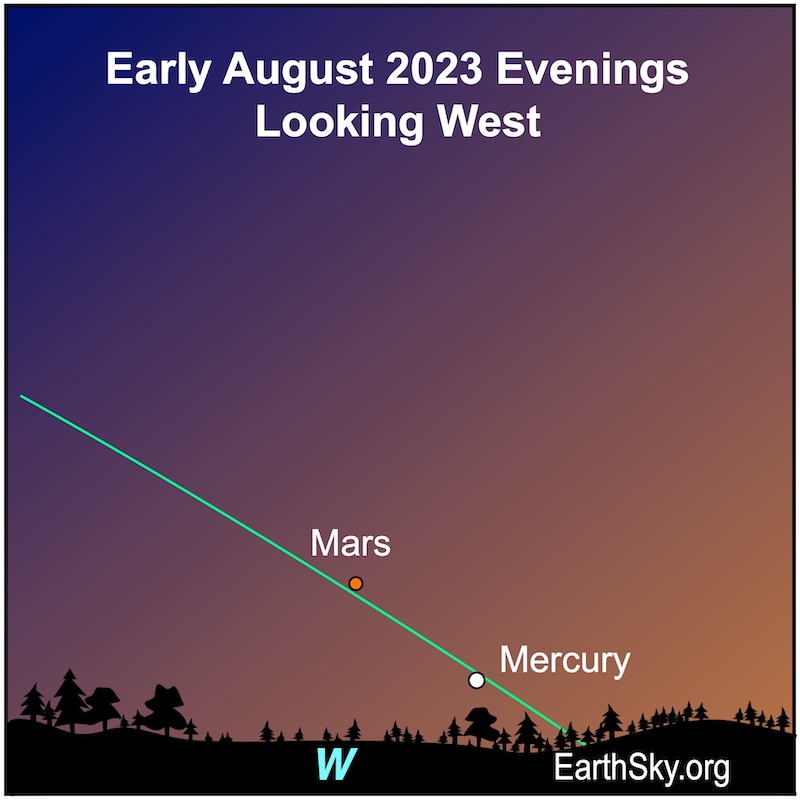
Mercury will reach its greatest elongation on August 9-10, 2023. It’ll be the best Mercury elongation of the year for the Southern Hemisphere.
Mercury in August 2023
Where to look: Look west, the sunset direction – shortly after sunset – for Mercury. The sun’s innermost planet should be easy to see, if you look west soon after sunset. Earth’s Southern Hemisphere has the best view.
Greatest elongation: Mercury is farthest from the sun – at greatest elongation – at 2 UTC on August 10, 2023 (9 p.m. CDT on August 9). It so happens Mercury reaches aphelion, its farthest point in orbit from the sun, on August 10, too. So, around August 9-10, Mercury is about as far from the sunset as it ever gets. It’s a whopping 27 degrees from the sun.
Brightness: Mercury began August 2023 already in the evening sky. And it has been bright so far, throughout early August. It’s been brighter than dim Mars, which is far across the solar system from Earth now, also in the west after sunset. At greatest elongation, Mercury shines at magnitude +0.3, making it brighter than most stars. But, after greatest elongation, the innermost planet will rapidly fade. It’ll probably disappear into the sunset glare around the 3rd week of August.
Through a telescope: Mercury will appear about 49% illuminated, at greatest elongation. It’ll measure 7.55 arcseconds across.
Constellation: Mercury will lie in front of the constellation Leo the Lion at this elongation. But most of stars of this constellation will be lost in the twilight.
Note: As the innermost planet, Mercury is tied to the sun in our sky. As a result, it never ventures very far above the horizon after sunset. So as soon as the sun disappears below your horizon, your clock starts ticking. Will you see the glowing point of light that is Mercury before it drops below the horizon, following the setting sun?
Mercury elongation from the Southern Hemisphere

For precise sun and Mercury rising times at your location:
Old Farmer’s Almanac (U.S. and Canada)
timeanddate.com (worldwide)
Stellarium (online planetarium program)
Mercury events in 2023
Note: Times are in UTC
Jan 7, 2023: Inferior conjunction (races between Earth and sun)
Jan 30, 2023: Greatest elongation (morning)
Mar 17, 2023: Superior conjunction (passes behind sun from Earth)
Apr 11, 2023: Greatest elongation (evening)
May 1, 2023: Inferior conjunction (races between Earth and sun)
May 29, 2023: Greatest elongation (morning)
Jul 1, 2023: Superior conjunction (passes behind sun from Earth)
Aug 10, 2023: Greatest elongation (evening)
Sep 6, 2023: Inferior conjunction (races between Earth and sun)
Sep 22, 2023: Greatest elongation (morning)
Oct 20, 2023: Superior conjunction (passes behind sun from Earth)
Dec 4, 2023: Greatest elongation (evening)
Dec 22, 2023: Inferior conjunction (races between Earth and sun)
Heliocentric view of Mercury August 2023
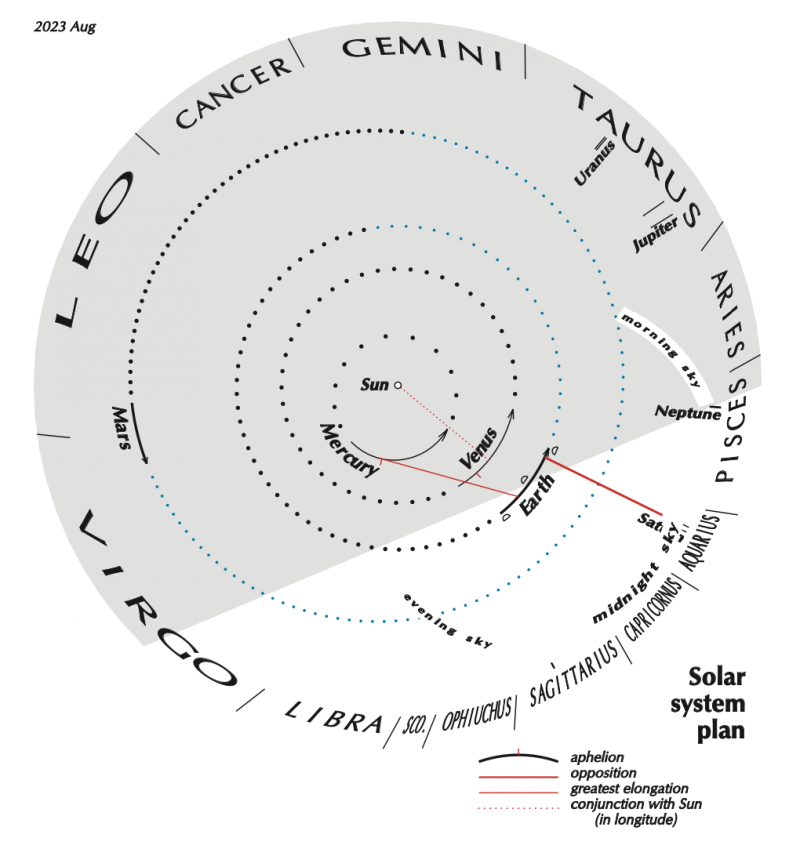
Overview of a Mercury elongation
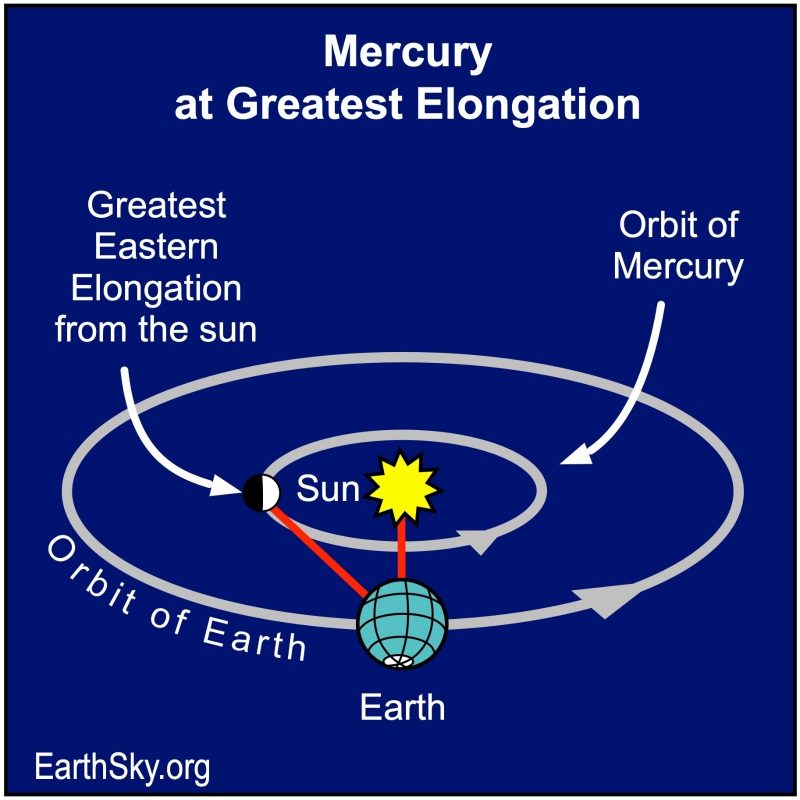
A comparison of elongations
The farthest from the sun that Mercury can ever appear on the sky’s dome is about 28 degrees. And the least distance is around 18 degrees.
Also, elongations are better or worse depending on the time of year they occur. So in 2023, the Southern Hemisphere will have the best evening elongation of Mercury in August 2023. And the Northern Hemisphere had the best evening apparition in April.
In the autumn for either hemisphere, the ecliptic – or path of the sun, moon and planets – makes a narrow angle to the horizon in the evening. But it makes a steep slant, nearly perpendicular, in the morning. So, in autumn from either hemisphere, morning elongations of Mercury are best. That’s when Mercury appears higher above the horizon and farther from the glow of the sun. However, evening elongations in autumn are harder to see.
In the spring for either hemisphere, the situation reverses. The ecliptic and horizon meet at a sharper angle on spring evenings and a narrower angle on spring mornings. So, in springtime for either hemisphere, evening elongations of Mercury are best. Meanwhile, morning elongations in springtime are harder to see.
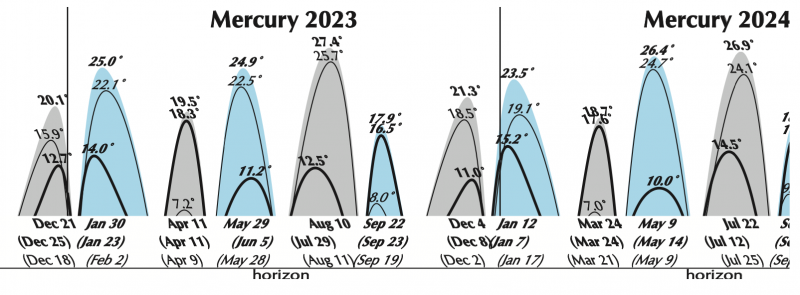
More Mercury elongation comparisons for 2023


Mercury photos from our community

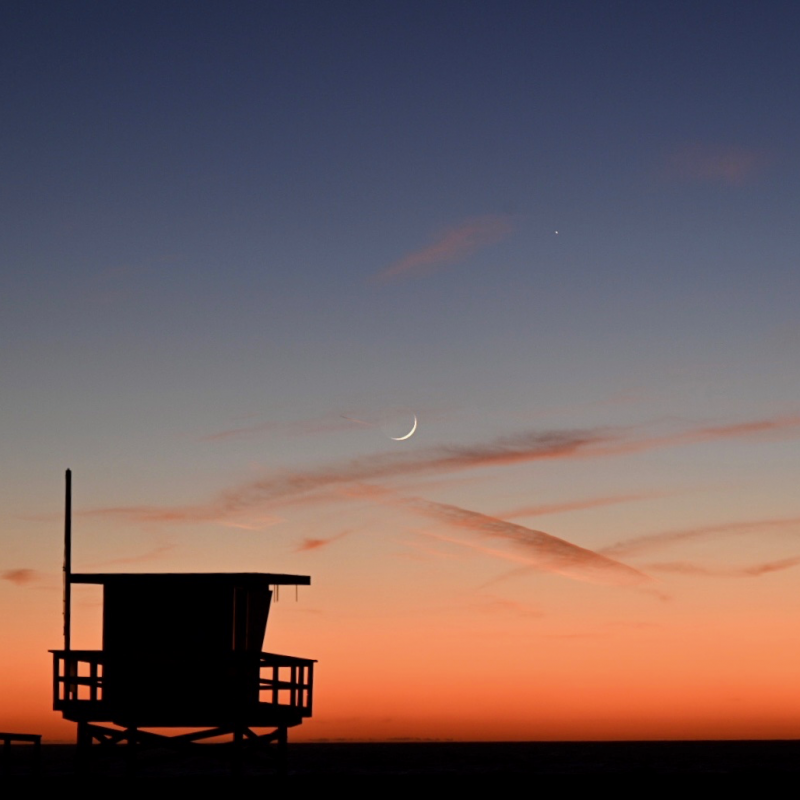

Bottom line: Mercury is visible in the evening sky. Look in the west as the sky is darkening. The planet will reach its greatest elongation overnight on August 9-10, 2023.
Submit your photos to EarthSky here.
Read about greatest elongations, superior and inferior conjunctions: Definitions for stargazers
The post Mercury at greatest elongation, August 9-10, 2023 first appeared on EarthSky.
0 Commentaires